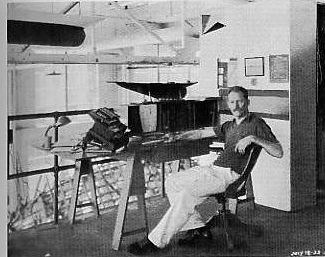Burgess was one of the great, 20th century geniuses of American design, with an extraordinary range of fields, as a inventor, poet, aviation pioneer, naval architect, automotive engineer, and America’s Cup yacht designer.
Born into a Boston family of wealth and privilege on Christmas Day, 1878, the son of yacht designer Edward Burgess and Caroline Louisa “Kitty” Sullivant, an eminent natural scientist. Orphaned by the age of 12, after his parents died within months of each other (typhoid Fever, pneumonia), Burgess was raised by relatives, and mentored by many of his father’s legendary colleagues, including George Lawley Jr, Arthur Binney, and Nathanael Greene Herreshoff, assuring him of future success in yacht design. Burgess received his first patent (for a recoil-operated machine gun) at the age of 19, and published his first (and only) book of poetry at the age of 24, following the suicide, diagnosed with an incurable disease, of his first (of five) wives in 1902. By his second wife, Burgess had three children, among them the celebrated creator of books for young readers, Tasha Tudor.
Burgess graduated from Milton Academy in 1897 and entered Harvard College in 1901, where he excelled in scientific and engineering subjects. A lifelong student of navy warfare, Burgess took a leave of absence from school to enlist in the Navy at the start of the Spanish-American war. He returned to college after serving as a gunner’s mate on the USS Prairie, but then quit in the middle of his senior year, For reasons not entirely clear, and opened a yacht design and broker business, W. Starling Burgess & Co. in Boston in 1901.
The Wright Brothers’ initial flight in 1903 had a strong effect on Burgess. By 1909, he was heavily into aeronautics, Burgess-Herring Model A #1 pusher biplane “Flying Fish”, on February 28, 1910, became the first airplane to take flight in New England, from the frozen surface of Chebacco Lake, Hamilton, Massachusetts. Model A #1 was the first commercial aeroplane built and sold in New England, and the first U.S.-built aircraft sold abroad. His aircraft company, in Marblehead, Massachusetts, employed up to 800 men, built scores of military warplanes in World War I, before the main factory burned to the ground on the night of “False Armistice” day November 7, 1918, so-called because of an incorrect report that the war had ended, which occurred just days before the real armistice on Nov. 11, 1918. In 1915 he was awarded the highest prize in aviation, the Collier Trophy, just two years after Orville Wright won it.
It wouldn’t be until 1921 that Burgess returned to yacht design. Having devised a novel new rig for the sloop Vanitie, nearly beating the favored sloop Resolute in the America’s Cup trials. Later designed three fishing schooners in succession to compete against Canadian boats for the International Fishermen’s Trophy. In 1924 Burgess introduced a revolutionary new staysail rig on the all but unbeatable schooner yacht Advance. He also designed lovely one designs, including the Atlantic and Yankee classes. His 8-, 10-, and 12-Metres, and M and K (Manxman) class designs were marvels of yachting in the 1920s. After moving to New York City in 1928, Burgess designed the breakthrough stays’l schooners Nina and Advance.
Between 1930 and 1937 he created three America’s Cup-winning J-Class yachts, Enterprise, Rainbow and Ranger (the latter in partnership with Olin Stephens). And in between that time partnered with R. Buckminster Fuller in the design and construction of the path-breaking Dymaxion automobile.
Afflicted by gastric ulcers and addicted to morphine for much of his adult life, Burgess finally found medical relief on the eve of World War II, and while working under military contract enjoyed some of his happiest and most productive years as a naval architect and inventor.
Burgess’ biographer, Llewellyn Howland III, “The restless Burgess met challenges and had to move on,” “No telling what he would have done if he had worn just his yacht design cap for 50 years.”

